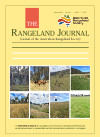
Volume 45 Number 1 2023
Keeping track of an animal’s weight gain is hard and causes stress, which can lead to health problems and weight loss. Sentinel-2 images, GPS collar data, and sheep weight data were used to look at the patterns of grazing and see how they relate to preferred grazing areas. The results suggest that sheep changed the way they grazed depending on the season.
RJ22049 Abstract | RJ22049 Full Text | RJ22049PDF (3.2 MB) Open Access Article
A systems modelling framework was used to analyse an 18-year monitoring data set from an Indian couch (Bothriochloa pertusa) dominated hillslope flume site in the Burdekin catchment, Australia. Results show important functional differences in B. pertusa pastures, relative to the native tussock pastures they replace, with implications for how grazing lands in Great Barrier Reef catchments are managed.
RJ22067 Abstract | RJ22067 Full Text | RJ22067PDF (2.6 MB) Open Access Article
Natural capital accounts provide a method to recognise the carbon storage value of native woodlands on farms and the potential for these areas to sequester carbon under low-input grazing. Areas of native woodland managed with low-input grazing can counter high carbon footprints of more intensive agricultural practices within a farm business, thus reducing overall farm business carbon footprint. Such an approach can potentially encourage practices that reverse further loss of a critically endangered ecosystem and its corresponding biodiversity in Australia.
RJ22053 Abstract | RJ22053 Full Text | RJ22053PDF (1.5 MB) | RJ22053Supplementary Material (1.1 MB) Open Access Article
RJ22065Tradeoff between production and regulation functions of semi-arid rangelands
One of the important reasons of rangeland degradation is that non-marketed services are usually ignored in planning and policies. We studied the tradeoff between regulation and production functions in semi-arid rangelands and found that despite their close relationship, by one degree of increase in the grazing intensity, the value of forage production and regulating services decreased by USD27.4 and USD245.2, respectively. These figures reveal that rangeland management policies should shift their focus from forage production to other ecosystem services.
Effective predator management is required for humans and wildlife to co-exist within the same spaces. We present a case where long-term incentivised lethal control of carnivores has failed to address losses to predation in rural areas and the institutions involved have been unable to agree on an alternative policy. This study has shown the difficulty in modifying existing management policies after an extended period of time, as well as the impact of having an urban-centric decision-making process.




